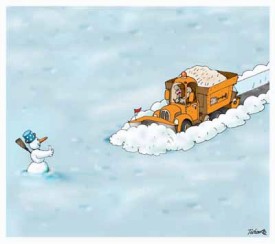Recognition of Kosovo
What would we say in Catalonia if Ripolles was filled with people hostile to the Catalan nation and asked to get independent from it?
(Xavier Hereu, El Periodico) Wednesday, June 11, 2008
The people of Serbia has spoken, and the pro-European democrats have won the latest parliamentary elections. But the Kosovo problem is as yet to be resolved since no Serbian political party recognizes its independence - the pro-European party, the winner of the elections, including.
This rejection of Kosovo's independence is understandable. There is a publication in Serbian and French, entitled "The Crucified Kosovo", a story illustrated with photographs, which relates in some detail how the Kosovo Albanians bombed the Kosovo churches and monasteries belonging to the Serbian Orthodox Church. There is another publication dated 1977, in Serbian and English, called "Spiritual Genocide", a story that also relates these facts, illustrating them with many photos and important data.
Now Kosovo has declared itself unilaterally independent and Serbia does not recognize it. Many European governments support the new State, but not Spain.
Spain does not recognize Kosovo but keeps asserting that the Kosovo problem has nothing to do with Catalonia, where people would rather say: "Either we are all Moors, or we are all Christians".
Down there, in the Balkans, Albanians do not talk about Catalonia, they just don't care about it. But in Serbia and Russia they say that Spain will have to give us (Catalonians) independence. Even if the radical Serbs, those who demonstrate in Podgorica, do hold the Spanish flag together with the Serbian one.
The truth is that every politician compares Spain with Serbia, and Kosovo with Catalonia, but there is some mistake here: They should be comparing Catalonia with Serbia, and Kosovo with Ripolles (the cradle of Catalonia).
Let me explain this. The Serbian nation is an old one, and its cradle is located in Kosovo. In the year 1113, Prince Stefan Nemanja was born, son of Zavida, Lord of Duklja - today known as Podgorica. He unified all Serbian territories and became the first Great King of that nation. In 1155, when he was 42, Catalonia constructed the Church of Saint Joan of Abadesses, and in 1172 the Cloister of Saint Mary of Ripolles. Nemanja's son, Rastko, became the Archbishop of the Serbian Church in 1219.
After his death, Rastko Nemanjic was canonized by the Serbian Orthodox Church under the name Saint Sava. Later, in the town of Pec, also in Kosovo, the patriarchal temple of Serbia was built. In 1213, in Catalonia, Pere I died and so began the era of Jaume I The Conqueror.
Therefore, the birth of the Serbian and Catalonian nations, near the Mediterranean, are very close in time.
In 1459, six years after the fall of Constantinople and ten years before the marriage of Prince Fernando of Catalonia and Aragon and the princess Isabel of Castilla, Serbia fell under Turkish power.
Serbia recovered from all this by 1912. Churches and monasteries, destroyed by the Turks, were rebuilt during the 19th Century and in the first half of the 20th Century. In Kosovo, the Christian and the Islamic cultures existed side by side, but during Tito's Yugoslavia, many Albanians who did not share the Christian civilization, emigrated to the Serbian lands. The most radical ones were busy destroying Kosovo's churches and monasteries that the Turks had destroyed once already, and that Serbs had rebuilt.
Destructions were particularly brutal and have been carried out in total impunity since the early 90-ies. American and European soldiers on a peace mission there were unable to prevent it. Understandably, each flare of violence was followed by an exodus of Serbs living near those historical monuments. That's how, little by little, the Albanian population grew and grew to become ultimately much more numerous than the Serbian one.
The international magazine "Grand Tour" dated May and June 1999, that can be read in Italian, English, French and Spanish, published a work about the destruction of churches in Kosovo under the title "The Lacerated Memory". The topic was also discussed in the magazine's editorial where it is said - concerning the destroyed temples - that "beyond their esthetical value, they are the most tangible testimonies of a nation's identity, culture, and civilization".
What would we say in Catalonia if Ripolles was filled with people hostile to the Catalan nation and if they demanded independence from it?
Kosovo - the Serbian Ripolles - has declared itself independent. They do not have any national tradition there. They have no national anthem, no historical roots, no national flag either - they just invented one joining the region's map and the colours of Europe.
And the question that we should now address to the USA and the European Union is the following: What would you say, you who have recognized the independence of a region of Serbia - a region without national flag or anthem, without historical tradition as a nation - if we, Catalonians, were to declare independence?
We do have a historical tradition, we have the oldest national anthem in Europe, we have an ancient
national flag, our own language and culture. Would you support us in the same way you supported Kosovo?
Let me remind you of the old saying: "Either we are all Moors, or we are all Christians". It is a popular saying, but also a principle of justice. And may I also remind you that creating precedents may have political and legal consequences.
*Xavier Hereu is lawyer, poet and rector of the Orthodox church of Madre de Deu de la Tendresa (Girona)







